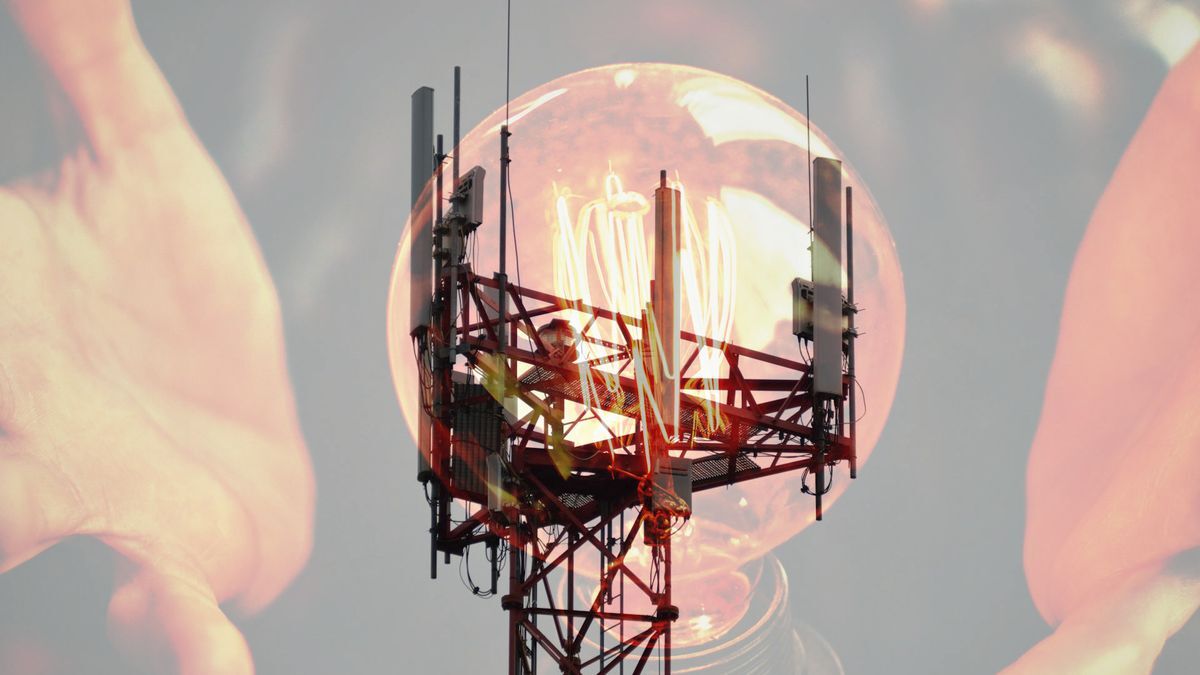it’s called an antenna. That’s its job.
In no way is this a discovery.
This is what crystal diode radios are from the '40s.
Some guy built one in Japan, it’s basically just a thousand transceivers in a box hooked up to a USB port harvesting radio/wifi signals.
Here’s a guy using them to make light:
It’s super cool, but not a discovery.
A friend of mine was working on a car chassis and that thing suddenly started to receive radio. You could faintly hear it coming from the chassis and not from somewhere else. We thought we were going crazy. Touching the chassis made it go away.
When I was a kid, I got a stereo system for my birthday one year alongside two big speakers. The speakers, if they stayed powered while the stereo was off, would receive faint traces of radio signal. So round midnight when the house is quiet I could always hear faint voices, just barely loud enough to hear, but quiet enough to make you wonder if you’re really hearing it. Nearly scared the dick off me, I thought my parents gave me a haunted stereo. No, turns out it was just haunted by the ghosts of local AM radio.
I remember making a crystal diode radio with my dad as a kid. You can still buy kits for those.
This would be neat for a bunch of passive IoT buttons. No need for a piezo to generate power, good for a couple presses at a time, just simple stuff like that.
Charge up a capacitor and allow a single button press to send a radio signal. Or maybe have enough power to send a WiFi signal.
I wonder if it could power a sensor. Something like a soil dampness or thermometer, where you only need a few updates per day. Could be pretty cool for passive monitoring applications.
Definitely not new. This is how RFID tags work. They harvest energy from the transmitter to power the circuitry in the tag to send back a response.
And low-power really means low powered… Like… milliamps. If you fed an RFID chip directly, you’d need to supply about 1 mW depending on the specific chip… 1 milliwatt…
In order to feed that chip with a transmitter you feed up to 2W. So up to 99.95% losses… It’s NOT economical for any other device that isn’t super low power.
Hell Qi charging is just as bad. Qi2, newest and greatest… Which you basically have the devices touching only get up to 80% at absolute best efficiency numbers. Every mm you add, drops that number significantly.
None of this is going to enable “battery free” for basically anything that any consumer would care to be battery free. And honestly I wish we wouldn’t pump the airwaves with all sorts of garbage just because it enabled the most minimal amount of “convenience” for things that never needed to be convenient to begin with.
Tap-to-pay on credit card chips, too.
Not new indeed. Kinda reminds me of old Nextel phones that you would put a little LED on the antenna and it would blink from the EMI when sending and receiving data.
Once its implementation is feasible and it can extract the waste energy efficiently, this innovation will enable new types of devices and uses that will be critical for commercial, scientific, medical and personal.
Sounds like it’s still more theoretical than realized, at this point. Still, I can’t help thinking this would be really cool for something like a watch or hearing aids.
It’s realized, just not scaled.
I was a little careless with how I phrased that. They said in the article they’ve done it, but it’s not “realized” in the sense that it’s not to a level of practicality that they’d want it to be. It can currently harvest signals to -20dBm, but they think they can get that to -62dBm for greater efficiency.
The main hurdle, according to them, is there’s no schottky diode that fits their needs, and they’ll have to engineer a new variant (at the nano scale…?). So, still a theoretical possibility on a more practical level, but this is hopeful news nonetheless.
https://en.m.wikipedia.org/wiki/Rectenna
What they’ve done here is use the very old existing rectenna technology and new types of nanoscale rectenna arrays to capture very low energy radio waves without an external antenna. We’re taking -20 dBm or 10 μW.
In the end, I welcome any rectenna advances because if we ever build an efficient optical rectenna it’ll blow photovoltaics out of the water by efficiency. Optical rectennas are like fusion power in just how revolutionary they would be to our energy economy.
Wouldn’t this just decrease the reception for rf devices? Isn’t it just stealing power from the system to power other devices?
No more than any random objects.
Think of it like a solar panel. Yes, it blocks light from things behind it, but it doesn’t suck light from nearby.
That’s interesting! I thought that if you for example have a 50w RF transmitter, taking 40w from it would make it act as a 10w one for the other devices around it.
Thx for the explanation :3
It you could build a 40w antenna sure, but it’d basically have to be a dome surrounding the transmitting one at that point.
I would find this super cool if it wasnt for the fact that all of the radio frequencies are owned by the military and corporations. Outdoor IoT could be amazing, but it is kind of dead because you cant actually connect it to the internet without laying down cable or using 4G which is horrible for low power applications.
I don’t know what kind of idea you are getting. Radio and wi-ifi are waves. The wave is what can be used, you don’t care who generated it. To say it somehow the wave is in the air and you just take advantage of it being there to convert it to energy. Doesn’t matter what the wave could have been read as. In general a radio station is not going to stop working for a whole region just to stop you from using it.
Maybe i left out too much context.
Im not talking about the research itself, but about how it could be utilized.
Their idea (having small devices that can be powered by nothing but stray radiowaves) apparently works and is great by itself.
However its usefullness is limited if you cant somehow connect those devices with the rest of the world. Thats the issue im complaining about.
There are tons of small devices that don’t have to be connected to be useful. Lots of personal items or small sensors.
Anything that can be powered by this research, can also be powered by a button sized battery for weeks if not not longer. I thinks its more intended for very off grid stuff but maybe im just too uncreative.
I just want it for my TV remote if the form factor is small enough
Isn’t that one of Nikola Tesla’s inventions? Free electricity through the air?
Nah, that was just blasting a microwave beam at a collector. It would work and be meh on efficiency, but also bake everything between the two points…neat innovative theory, bad idea. Tesla was a smart dude, but his bad ideas were left ignored for a reason.
That’s not right… He was trying to achieve wireless power through Earth resonance. Which AFAIK is pretty much now completely debunked as never going to work … but it tracks with Tesla’s world view.
It’s kind of crazy how much you can build without a complete understanding… There’s probably stuff we think we understand now that we really don’t and other stuff left to discover.
how much you can build without a complete understanding
We’ve never actually never had one. I’d have to check the timelines but Tesla was almost certainly working on a functional, but inaccurate atomic model (Bohr). Medicine is actually a great example of all this. We are so used to just kind of knowing “there’s a bad bug or bad gene that’s making me sick”. Like you may not know the details, but you’ve got some loose concept a bunch of cells in your body are pissed off. For the vast, vasssssssst history of medicine, it was all empirical, and the thing is, it kind of worked… sometimes.
My favorite example of “knowing without fully understanding” is Mendel and his peas. If you do a 4x4 punnet square (that gene cross thing), and look at the frequency of co-inheritance, you can track how far genes are from on another (because the further they are, the more likely there will be a swap during the shuffle). Thing is… because DNA is an integer thing (no such thing as ‘half a base pair’) it works DOWN TO THE SINGLE BASE PAIR. Mendel was accurately counting the number of freaking base pairs separating genes without knowing what a base pair, or indeed even really a molecule, was.
Tesla would have lived to see some absolutely nutty stuff in physics. Boltzman, Einstein with relativity, it must have seemed like pure madness at the time.
So yeah, we discover new and interesting stuff all the time. I personally think that some of the weird quantum stuff is going seem as rote in the future as germs do to us now. As in, the same way any lay-person shoved into a time machine would at least be able to give the basics to a medieval European, someone from the future would be like “well I don’t remember much about quantum tunneling, but…”.
And that’s all before getting into some of the bizarre things going on in math itself. Be careful if you look into that stuff though, it’s easy to fall into the “Terrance Howard” style rabbit hole. Suffice to say there is some really interesting and unexpected implications we’re discovering, but if you don’t have a solid grasp of theory, it is easy to be led astray but sources that want to gloss over details to talk about a conclusion that isn’t actually supported. It’s like if you tried to explain time dilation to an ancient Greek, and they excitedly hopped on their fastest chariot thinking they could “fast forward” to the future, because time moves “more slowly” for you when you’re going faster, right?
Tale as old as time. And guess what will happen? Wifi signal strength will go down.
how exactly? What will physically happen?
Any receiving antenna is basically an energy harvesting device. Usually, it is specially designed to harvest just enough energy to actually receive the signal in order not to weaken the field. In the 2.4GHz spectrum, where WiFi and BT are at home, a sender is limited to 10mW of power. The more power energy harvesting devices draw from this field, the less will be available for other devices to actually receive the information.
Technically, an electromagnetic field of a frequency f will induce an alternating current in an antenna of length lambda/2 (or lambda/4 or even lambda/8, with less power received the smaller they get and lambda=wavelength=speed of light/frequency) that the receiver can “take out” at the antennas mid point and feed it into an amplification circuit.
Wouldnt the effect be very local? How far could the harvester affect the field? But i suppose it would be quite annoying if multiple people used something like that in densely populated area.








